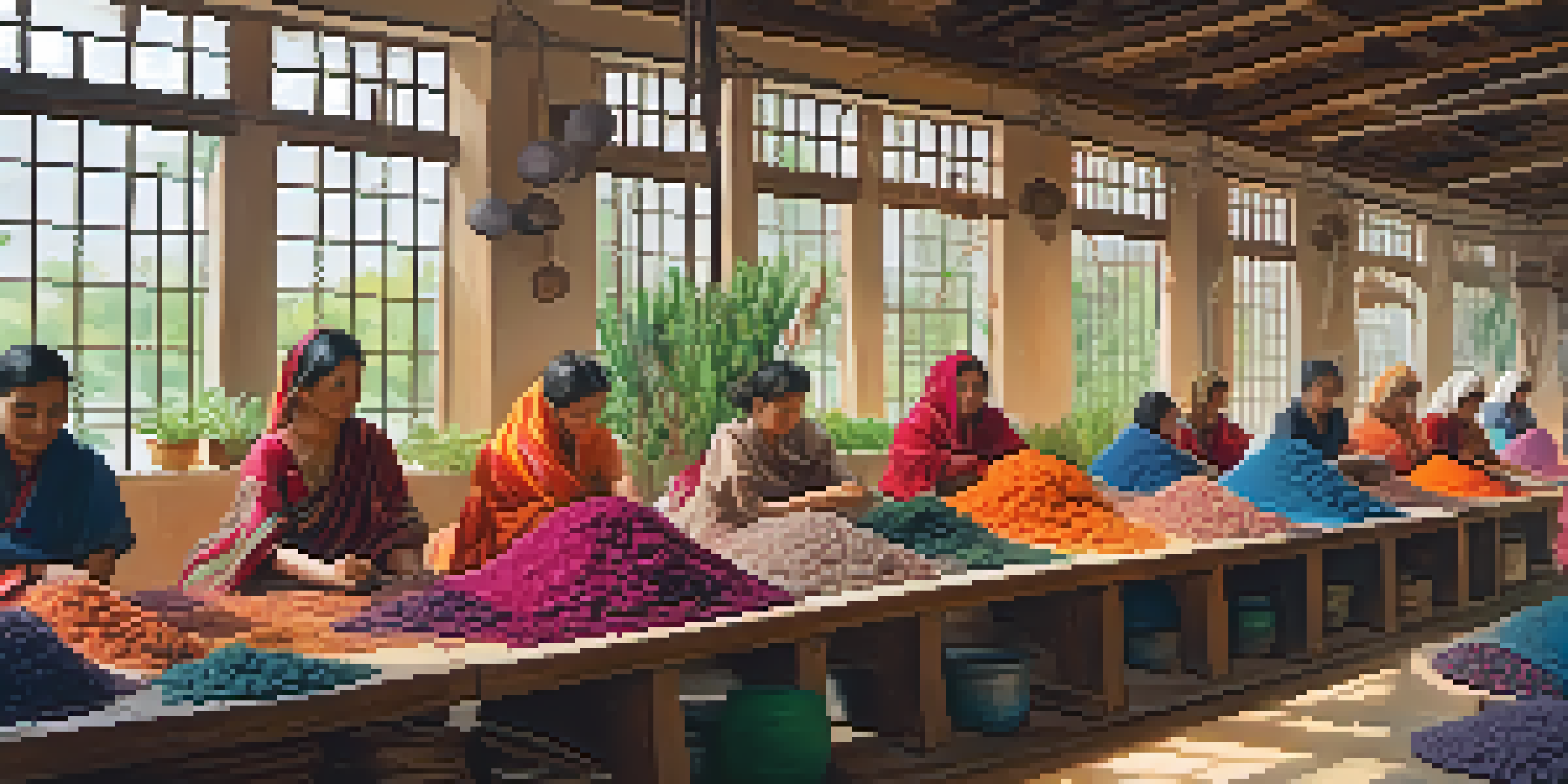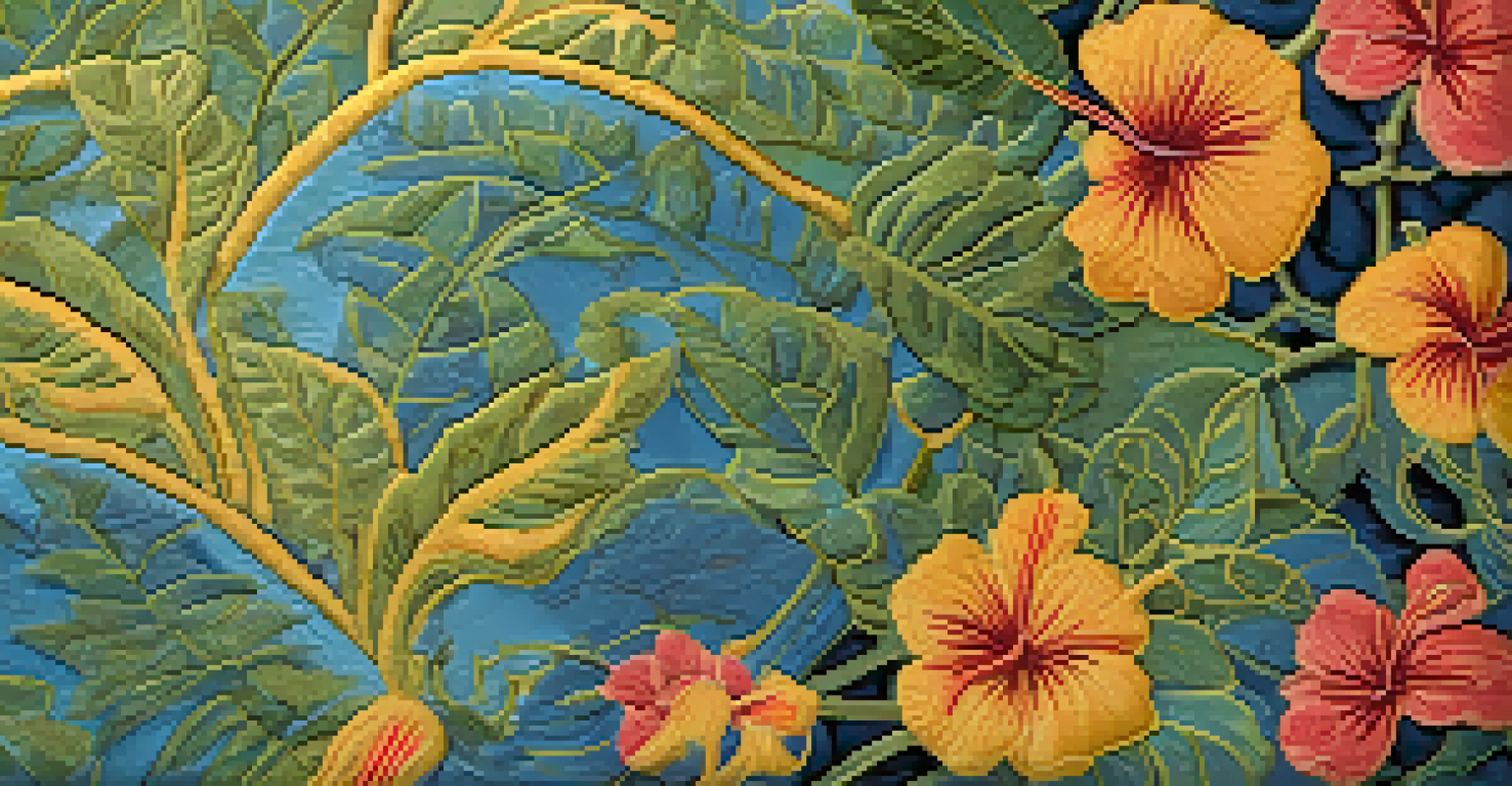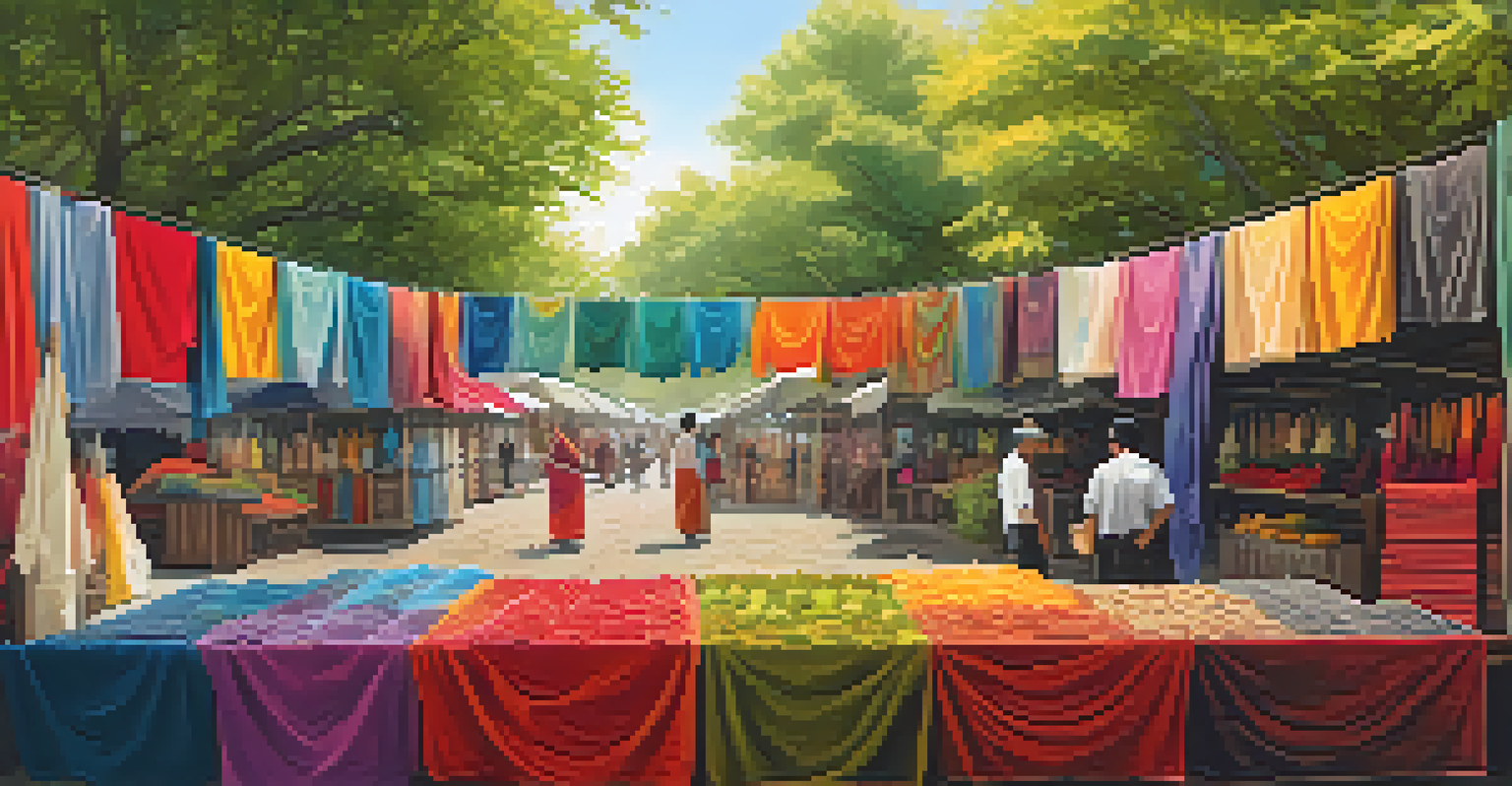Plant-Based Dyes: Cultural Significance in Textile Traditions

Understanding Plant-Based Dyes: A Brief Overview
Plant-based dyes are natural colorants derived from various plants, including roots, leaves, flowers, and bark. This traditional method of dyeing has been practiced for centuries, offering a sustainable alternative to synthetic dyes. The vibrant hues produced by these dyes not only enhance the beauty of textiles but also connect us to our cultural roots and heritage.
Color is the keyboard, the eyes are the harmonies, the soul is the piano with many strings.
Unlike synthetic dyes, which can contain harmful chemicals, plant-based dyes are eco-friendly and biodegradable. They often require less energy to produce, making them a more sustainable choice for the environment. This shift towards natural alternatives is gaining momentum as people become more conscious of their ecological footprint.
The colors obtained from plant-based dyes are often more muted and complex, which many artisans and designers find appealing. This uniqueness allows textile artisans to express their creativity while honoring age-old traditions. The process of dyeing with plants can also be seen as an art form, showcasing the skill and knowledge passed down through generations.
Cultural Significance of Plant-Based Dyes Worldwide
Around the globe, plant-based dyes are deeply intertwined with cultural identities and practices. For instance, in India, the use of indigo for dyeing textiles has a rich history, with artisans developing unique techniques to produce stunning shades of blue. This tradition not only reflects the artistry of the region but also serves as a source of pride and cultural heritage.

Similarly, in Africa, vibrant colors from plants like hibiscus and marigold are used in traditional fabric-making, symbolizing various cultural meanings and stories. These colors often represent community, identity, and even social status, illustrating how textiles play a crucial role in cultural expression.
Plant-Based Dyes: A Sustainable Choice
Plant-based dyes are eco-friendly alternatives to synthetic dyes, offering vibrant colors while minimizing environmental impact.
In South America, indigenous communities have long utilized natural dyes from local flora, creating textiles that tell stories of their ancestry and connection to the land. Each dye and pattern holds significance, allowing wearers to carry a piece of their heritage with them. This richness in storytelling showcases the profound relationship between culture and the art of dyeing.
Traditional Techniques of Plant-Based Dyeing
The process of dyeing with plant-based materials often involves traditional techniques that have been perfected over generations. Artisans typically begin by preparing the plant materials, extracting pigments through boiling or soaking. This careful preparation ensures that the dyes yield vibrant and lasting colors on textiles.
The earth has music for those who listen.
After extracting the dye, the fabric is often pre-treated with a mordant, which helps the dye bond to the fibers. Common mordants include natural substances like alum or iron, which not only enhance the color but also add depth to the final product. This step is crucial, as it greatly influences the longevity and vibrancy of the dye.
Once the fabric is dyed, it undergoes a rinsing process to remove excess dye, followed by drying in natural sunlight. This step not only sets the color but also imbues the textiles with a unique charm, as each piece becomes a testament to the artisan's skill and the natural materials used. The resulting fabrics are often celebrated for their beauty and individuality.
The Revival of Plant-Based Dyes in Modern Fashion
In recent years, there has been a notable resurgence of interest in plant-based dyes within the fashion industry. As consumers increasingly seek sustainable and ethically made products, many designers are turning to natural dyes as a way to enhance their collections. This shift not only supports traditional artisans but also promotes eco-conscious practices in the fashion world.
Brands are now exploring innovative ways to incorporate plant-based dyes into contemporary designs, marrying traditional techniques with modern aesthetics. The result is a beautiful fusion of old and new, where each piece tells a story of heritage while appealing to today's conscious consumer. This not only elevates the fashion experience but also encourages a deeper appreciation for the craft behind each item.
Cultural Heritage Through Dyeing
Plant-based dyes are deeply rooted in cultural identities worldwide, reflecting traditions and stories unique to each community.
Moreover, this revival has led to a greater awareness of the environmental impact of clothing production. By choosing plant-based dyes, consumers contribute to a more sustainable fashion industry, reducing the reliance on harmful synthetic dyes that pollute water systems. This positive change empowers both consumers and artisans, creating a more responsible and connected fashion landscape.
Challenges Facing Plant-Based Dyeing Practices
Despite the growing popularity of plant-based dyes, there are still several challenges that artisans face. One major issue is the availability and sustainability of plant materials, as overharvesting can threaten certain species. This emphasizes the need for responsible sourcing and cultivation practices to ensure that these natural resources remain plentiful for future generations.
Additionally, the labor-intensive nature of traditional dyeing methods can be a barrier for artisans, especially in a fast-paced fashion industry that often prioritizes speed and efficiency. Many artisans struggle to compete with mass-produced synthetic options that can be produced at a fraction of the cost. This financial pressure can undermine the traditions and skills that have been passed down through generations.
Lastly, there is a need for greater education around plant-based dyes and their cultural significance. Many consumers may not be aware of the stories and craftsmanship behind these textiles, which can lead to a lack of appreciation. By raising awareness, we can foster a deeper respect for these practices and support the artisans who dedicate their lives to preserving these traditions.
Connecting with Nature Through Plant-Based Dyes
One of the most beautiful aspects of using plant-based dyes is the connection it fosters between people and nature. Working with natural materials allows artisans to develop a profound understanding of the plants they use, often leading to a deeper appreciation for biodiversity. This relationship encourages sustainable practices, as artisans become more aware of the impact their choices have on the environment.
Furthermore, engaging with plant-based dyes can inspire a sense of mindfulness and creativity. The process of selecting plants, experimenting with colors, and creating unique patterns can be incredibly fulfilling. This hands-on approach to textile art not only enhances creativity but also promotes mental well-being by allowing individuals to immerse themselves in the natural world.
Challenges and Future of Dyeing
Despite their resurgence, artisans face challenges like resource sustainability and competition with mass production, but the future looks bright with growing consumer interest in sustainable fashion.
As consumers, supporting plant-based dyes can also be a way to reconnect with nature. Choosing textiles dyed with natural materials encourages a more intentional approach to fashion and consumption. By valuing the stories, traditions, and environmental benefits of plant-based dyes, we can collectively contribute to a more sustainable and harmonious relationship with our planet.
The Future of Plant-Based Dyes in Global Textile Traditions
Looking ahead, the future of plant-based dyes appears promising as more people embrace sustainable practices. The blend of traditional techniques with modern innovations creates exciting opportunities for artisans and designers alike. By reimagining how we approach dyeing, we can breathe new life into age-old traditions while also addressing contemporary environmental concerns.
Additionally, the growing global market for sustainable fashion is likely to drive further interest in plant-based dyes. As consumers become more educated about the benefits of natural dyes, demand for these products will rise, encouraging more artisans to share their craft. This shift can lead to a revitalization of communities, where traditional skills are valued and preserved.

Ultimately, the future of plant-based dyes hinges on our collective commitment to sustainability, cultural heritage, and artistic expression. By honoring the past while embracing innovation, we can ensure that these beautiful traditions continue to thrive for generations to come. The journey of plant-based dyes is not just about color; it's about weaving stories, cultures, and nature into the fabric of our lives.